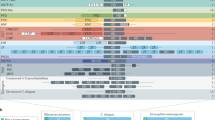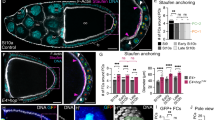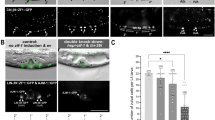Abstract
The Pax-6 transcription-factor gene, containing a paired domain and a paired-type homeodomain, is conserved in structure and ubiquitously present among Metazoa1á¤-5. It is required for develop-ment of the central nervous system, and is mutated in human aniri-dia, mouse and rat small eye and Drosophila eyeless6. We identified the Pax-6 gene of the nematode Caenorhabditis elegans in genetic studies of male tail morphology7,8. C. elegans Pax-6 encodes at least two independent genetic functions. One, like other Pax-6 genes, contains paired and homeodomains; this constitutes the genetic locus vab-3 (ref. 9). The other, described here, is expressed from an internal promoter and contains only the homeo-domain portion; this constitutes the genetic locus mab-18 (ref. 7). The mab-18 form of the gene is expressed in a peripheral sense organ and is necessary for specification of sense-organ identity. Its function in this context could be to regulate the expression of cell recognition and adhesion proteins required for sense-organ assembly.
This is a preview of subscription content, access via your institution
Access options
Subscribe to this journal
Receive 51 print issues and online access
$199.00 per year
only $3.90 per issue
Buy this article
- Purchase on Springer Link
- Instant access to full article PDF
Prices may be subject to local taxes which are calculated during checkout
Similar content being viewed by others
References
Walther, C. & Gruss, P. Development 113, 1435–1449 (1991).
Püschel, A. W., Gruss, P. & Westerfield, M. Development 114, 643–651 (1992).
Glaser, T., Walton, D. S. & Maas, R. L. Nature Genet. 2, 232–239 (1992).
Quiring, R., Walldorf, U., Kloter, U. & Gehring, W. J. Science 265, 785–789 (1994).
Czerny, T. & Busslinger, M. Molec. cell. Biol. 15, 2858–2871 (1995).
Hanson, I. & Van Heyningen, V. Trends Genet. 11, 268–272 (1995).
Baird, S. E., Fitch, D. H., Kassem, I. A. & Emmons, S. W. Development 113, 515–526 (1991).
Chow, K. L. & Emmons, S. W. Development 120, 2579–2593 (1994).
Chisholm, A. D. & Horvitz, R. Nature 377, 52–55 (1995).
Lewis, J. A. & Hodgkin, J. A. J. comp. Neurol. 172, 489–510 (1977).
Hedgecock, E. M., Culotti, J. G., Hall, D. H. & Stern, B. D. Development 100, 365–382 (1987).
Carriere, C. et al. Molec. cell. Biol. 13, 7257–7266 (1993).
Sulston, J. E., Albertson, D. G. & Thomson, J. N. Devl Biol. 78, 542–576 (1980).
Hedgecock, E. M. Trends Neurosci. 8, 288–293 (1985).
Chamberlin, H. M. & Sternberg, P. Devl Biol. 170, 679–689 (1995).
Burr, A. H. Photochem. Photobiol. 41, 577–582 (1985).
Chow, K. L., Hall, D. H. & Emmons, S. W. Development (in the press).
Krause, M. & Hirsh, D. Cell 49, 753–761 (1987).
Mello, C. C., Kramer, J. M., Stinchcomb, D. & Ambros, V. EMBO J. 10, 3959–3970 (1991).
Okkema, P. G. & Fire, A. Development 120, 2175–2186 (1994).
Palazzolo, M. J. et al. Gene 88, 25–36 (1990).
Fire, A., White-Harrison, S. & Dixon, D. Gene 93, 189–198 (1990).
Chalfie, M., Tu, Y., Euskirchen, G., Ward, W. W. & Prasher, D. C. Science 263, 802–805 (1994).
Clark, S. G., Lu, X. & Horvitz, H. R. Genetics 137, 987–997 (1994).
Author information
Authors and Affiliations
Rights and permissions
About this article
Cite this article
Zhang, Y., Emmons, S. Specification of sense-organ identity by a Caenorhabditis elegans Pax-6 homologue. Nature 377, 55–59 (1995). https://doi.org/10.1038/377055a0
Received:
Accepted:
Issue Date:
DOI: https://doi.org/10.1038/377055a0
This article is cited by
-
Homeodomain proteins: an update
Chromosoma (2016)
-
mab-31 and the TGF-β pathway act in the ray lineage to pattern C. elegansmale sensory rays
BMC Developmental Biology (2010)
-
The Drosophila Pax6 paralogs have different functions in head development but can partially substitute for each other
Molecular Genetics and Genomics (2009)
-
The Evolution of Alternative Splicing in the Pax Family: The View from the Basal Chordate Amphioxus
Journal of Molecular Evolution (2008)
-
A Genetic Perspective on Eye Evolution: Gene Sharing, Convergence and Parallelism
Evolution: Education and Outreach (2008)
Comments
By submitting a comment you agree to abide by our Terms and Community Guidelines. If you find something abusive or that does not comply with our terms or guidelines please flag it as inappropriate.



